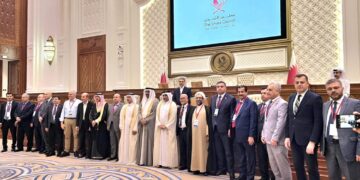WASHINGTON D.C. – After Congress passed the Bipartisan Infrastructure Deal, the Biden Administration launched a campaign to promote the infrastructure package and highlight what it means for the American people.
President Biden visited the Port of Baltimore to showcase how the legislation will ease supply chain blockages. And, Cabinet Members and senior administration officials hit the ground running. They flooded local TV airwaves, hosted media briefings, and outlined their first steps to implement the legislation so that it delivers results for middle class families across America, grow a competitive economy for years to come, and create good-paying, union jobs. The White House also convened more than a dozen briefings with over 4,000 leaders across the country – Governors, Mayors, state legislators, Members of Congress, union members, business leaders, and more.
After the President signs the bill into law next week, he will travel to New Hampshire and Michigan to continue underscoring the benefits the Bipartisan Infrastructure Deal delivers to the American people, and key agencies and administration leaders will continue formulating plans to quickly deliver and communicate about the historic legislation.
Cabinet Members flooded media and are traveling the country to highlight what it means for the American people:
- Transportation Secretary Buttigieg joined the White House press briefing to discuss the transformational investments in our roads, bridges, ports, airports, railways, and more that will make the country more resilient and competitive.
- Commerce Secretary Gina Raimondo also joined the White House press briefing to share insight on the department’s plans to help close the digital divide and deliver high-speed internet to all Americans.
- Interior Secretary Deb Haaland authored an op-ed in the Seattle Times explaining how the deal will strengthen the resilience of coastal tribal communities particularly threated by climate change.
- Energy Secretary Jennifer Granholm traveled to Philadelphia, Pennsylvania to meet with homeowners and discuss how the deal will invest in weatherization to make homes more efficient, lower energy bills, and create healthier communities.
- EPA Administrator Michael Regan spoke with the Nextsar local media group to showcase how the package will expand access to clean water and address pollution, and he will travel across the south next week.
The White House hosted regional media briefings for local reporters across the country:
- Energy Secretary Jen Granholm and NEC Deputy Director David Kamin discuss how the infrastructure deal delivers electric vehicle infrastructure to states like Missouri and fund essential services in states like Idaho.
- Deputy Transportation Secretary Polly Trottenberg and NEC Special Assistant to the President for Transportation Policy Samantha Silverberg discussed the deal’s transportation provisions will help create safer streets and prevent injuries in places like Virginia and make equity and accessibility a top priority in infrastructure projects.
- Deputy Commerce Secretary Don Graves discussed plans to deliver high-speed internet to communities across the country allowing all Americans to engage in remote work and school, and be full participants in the digital economy.
Agencies outlined key provisions of the Bipartisan Infrastructure Deal they will help deliver on:
- Department of Transportation: What the Bipartisan Infrastructure Deal Will Mean for American Mobility
- Department of Commerce: Bipartisan Infrastructure Deal Will Help Close the Digital Divide
- Department of the Interior: Bipartisan Infrastructure Deal Will Clean Up Legacy Pollution, Protect Public Health
- Department of Energy: Bipartisan Infrastructure Deal Will Deliver For American Workers, Families and Usher in the Clean Energy Future
- Environmental Protection Agency: The Bipartisan Infrastructure Deal and Clean Water
Policy experts hosted media briefings to outline initial implementation plans:
- Deputy Transportation Secretary Polly Trottenberg focused on how the deal will create good-paying, union jobs by modernizing and improving our roads, ports, rails, bridges, and our supply chains.
- Deputy Commerce Secretary Don Graves discussed how the National Telecommunications and Information Administration (NTIA) will implement the largest broadband funding programs provided for in the deal to expand broadband access to tens of millions of Americans, make broadband more affordable, and support digital equity and inclusion efforts.
- Assistant Secretaries at Department of the Interior outlined how the deal will strengthen the resilience of our physical and natural systems, including funding for drought management, wildland fire mitigation, and the resilience of Tribal communities.
- Experts from the Department of Energy detailed how the investments will help improve energy efficiency, lower costs for working families, and build an equitable, reliable, and clean power grid.
- EPA Assistant Administrator for Water Radhika Fox highlighted how the deal provides the single largest investment for water infrastructure in U.S. history, including removing lead pipes and addressing contamination to deliver clean water.
















